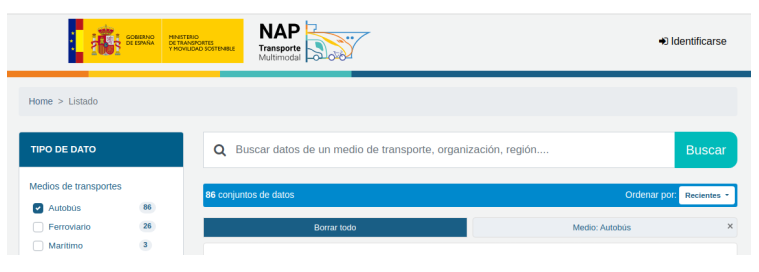
The need to inform public transport users
As a user of public transport I have found enormous difficulties in being able to locate in a simple and centralized way what means of public transport and what transfers I can make to travel from one point to another in Spain.
The information available is usually characterized by three things:
- At best, it is dispersed across multiple operators’ websites, at worst, we can only find the schedules by visiting bus stations or relying on a sign at a remote stop.
- It is an almost impossible task to know the different transportation options and how to combine them.
- The information available in some web applications is not reliable since it does not take into account the peculiarities of the concession system by which on a bus line between two points, in which there are different stops, we may be able to get on in one of them and think that we can get off at any of them, but it is not possible because certain stops are operated by another operator.
This perception is common and the European Union echoed it generating legislation on multimodal transport.
The obligation to provide information on routes, services and schedules in the NAP
On June 30, 2021, the Ministry of Transport, Mobility and Urban Agenda made the Spanish National Access Point for information services on multimodal travel available to the general public on the website https://nap.transportes. gob.es/

The creation of said National Access Point, or NAP in its English acronym, was included in article 3 of the Delegated Regulation (EU) 2017/1926 of the European Commission of May 31, 2017. This article establishes that the NAP is “a single point of access for users to, at a minimum, static travel and traffic data and historical traffic data for different modes of transport, including data updates, as indicated in the Annex, provided by transport authorities, transport operators, infrastructure managers, or providers of on-demand transport services in the territory of a Member State”.
Article 4 of the EU Delegated Regulation also indicated that “Transport authorities, transport operators, infrastructure managers, or providers of on-demand transport services shall provide static travel and traffic data through of the national access point in the required formats […] no later than December 1, 2023”
Among the static data to be provided are schedules, network topology and routes/lines, where and how to buy tickets for transportation.
Almost three years since the implementation of the NAP in Spain, there are more than 107 data sets in GTFS format shared by transport authorities and transport operators, but there are still dozens of transport operators that have not provided this information, not even the most basic, about their routes, trips or stops.
How to help transport companies comply with this obligation
In the creation of the Castilla y León route planner dozens of routes and schedules of a dozen transport companies that operate bus services within this autonomous community have been studied.

From that study I have developed tools to be able to deal with the laborious task of transforming the schedules dispersed on web pages and on bus station signs into structured information, based on GTFS files, which can be exploited by other applications such as Google Maps and that could be provided to the NAP to be able to share this information in compliance with the requirement established by the EU Delegated Regulation.
The existing tools to create these files are usually paid and involve a high cost, which is why I have developed my own tools to be able to carry out this work in a contained way and to be able to assist small and medium-sized companies in the generation of these files. In addition to the tools, it is necessary to have some knowledge of the GTFS format to be able to generate these files and why not be a public transport user.
If your company needs assistance to prepare these files, let’s talk.